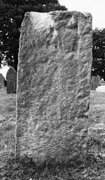Select a site alphabetically from the choices shown in the box below. Alternatively, browse sculptural examples using the Forward/Back buttons.
Chapters for this volume, along with copies of original in-text images, are available here.
Object type: Part of shaft [1]
Measurements: H. 70 cm (27.5 in); W. 30 > 29 cm (11.8 > 11.4 in); D. 19 > 18 cm (7.5 > 7 in)
Stone type: Angular-grained, pale red (10R 6/3), poorly sorted, feldspathic sandstone. Grain size varies from 0.1–1 mm. Namurian sandstone consistent with Roaches or Ashover Grit, Marsden Formation, Millstone Grit Group, Carboniferous (R.T.)
Plate numbers in printed volume: Ills. 481–4
Corpus volume reference: Vol 13 p. 265
(There may be more views or larger images available for this item. Click on the thumbnail image to view.)
A (broad): Very badly eroded and appears also to have been largely dressed off. A cable edge-moulding is visible on the right-hand side and faintly on the left. At the top is a very short length of curved interlace below which is a rounded element which could be the head of a figure, although this is far from certain.
B (narrow): Badly damaged at the base where dressing has removed the decoration for about two-fifths of its height. The surviving decoration comprises a two-stranded half-pattern interlace which appears to terminate at the bottom; it is truncated at the top where the stone has been broken. To the right is a badly eroded cable edge-moulding while that to the left is badly damaged and appears to have been partially chiselled away.
C (broad): Although eroded this face is relatively undamaged. It contains a single panel of plaited turned-pattern interlace comprising four stands which terminate at the bottom in closed-circuit loops; the pattern is truncated at the top where the stone has been broken. Below are two horizontal mouldings, the higher of the two being joined to the edge mouldings on each side. On the left-hand side is an edge-moulding which appears to have been of a cable type, although it is badly worn; on the right the edge moulding is badly damaged and appears to have been partially chiselled away.
D (narrow): The decoration has been badly damaged with the lower half dressed-off. That which remains comprises a simple interlace of three strands with a central groove. The pattern is truncated at the top where the stone has been broken off.
Being broken and badly damaged, the surviving decoration, which comprises interlace only, is not especially diagnostic in that such patterns are ubiquitous to the region and elsewhere. The stone has been reused as building material and is likely to have been incorporated in the church fabric before one of the phases of renovation took place.



